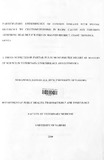| dc.description.abstract | Cryptosporidium is an important parasite that causes a potentially life-threatening disease in
immunocomprornised individuals worldwide. The disease also contributes significantly to
morbidity among calves and children in developing countries. Diagnosis of infection with this
parasite was previously based on identification of acid-fast oocysts in stool; however, of late
immunoassay techniques and peR-based assays have been used to increase the sensitivity of
detection. The organism is a major public health concern as its oocysts are resistant not only to
common antiseptics. There are currently no drugs that cure cryptosporidiosis unlike other
coccidian and enteric parasites. Prevention remains the most effective method of control.
Reports 011 cryptosporidiosis in Kenya remain scanty. Few studies have been done to assess the
prevalence of the disease. The status of cryptosporidiosis in animals and man in Malindi District,
Coast province of Kenya is not known. This study was designed determine the prevalence of
cryptosporidiosis in dairy calves and children in Malindi district. The objectives of the study
were to provide baseline data on cryptosporidiosis, to determine the important risk factors and
community perception associated with the disease.
The research was carried out in Malindi and Magarini administrative divisions ofMalindi district
in Coast province of Kenya. The participatory methodologies and acid fast staining of the
samples collected were used to collect and analyze data. Semi structured interviews were used to
come up with a list of eight diseases and or conditions in each division. In Malindi,
heliminthiasis, ectoparasites, coccidiosis, eye problems, pneumonia, East Coast Fever, Foot and
Mouth disease and diarrhea were the diseases listed while in Magarini, helminthiasis,
pneumonia, East Coast Fever, anaplasmosis, coccidiosis, foot and mouth disease, navel ill and
mucoid diarrhea were listed. In both divisions, cryptosporidiosis was not listed by the
participants but it was added to the list as it was the disease of interest. Seasonal calendar was
used to get the seasonality of the diseases.
By using pair wise ranking, the relative importance of the listed diseases as perceived by the
fanners was established. In Malindi, helminthiasis was the most important followed by
ectoparasites and diarrhea while in Magarini; East Coast Fever was the most important followed
by pneumonia and bloody diarrhea. Proportional piling was used to establish the perception of
the farmers on morbidity and mortality of the listed diseases. In Malindi division, ectoparasites
East Coast Fever, pneumonia had the highest morbidity and mortality. In Magarini, East Coast
Fever and pneumonia had the highest morbidity and mortality with morbidity. Matrix scoring
assessed the farmers' ability to identify the listed diseases by using disease-sign matrix. in
Malindi division, participants demonstrated good agreement for five out of the twelve disease
signs and moderate agreement in six out of the twelve of the disease signs. There was poor
agreement in one disease sign. In Magarini division, analysis of the disease-sign matrix scores
demonstrated good agreement between the participants for 5 out of the 11 disease signs and
moderate agreement between another 5 out of the 11 disease signs. There was poor agreement in
one disease sign.
On methods of disease prevention and control, matrix scoring established that the participants
strongly associated deworming with prevention and control of helminthiasis having a Kendall's
coefficient of 0.982 in Malindi and 0.964 in Magarini. Vaccination was strongly associated by
the participants with foot and mouth disease having a Kendall's coefficient of 0.964 and 0.946 in
Malindi and Magarini respectively. Proportional piling established the perception of the farmers
on the effectiveness, financial implications, ease of use and action needed whether group or
individual action of some disease prevention methods against the listed diseases. Participants in
both division demonstrated that hygiene was the most efficient method in controlling
cryptosporidiosis. Economic importance of the listed diseases was established by the use of
proportional piling. Participants in both divisions demonstrated that decreased growth rate and
decreased income were the most important economic importance indicators associated with
cryptosporidiosis.
Thirty-two calves tested positive for cryptosporidiosis giving a prevalence rate of 10.6 %
(32/300) in dairy calves under the age of six months while 9 children tested positive for
cryptosporidiosis giving a prevalence rate of 6.4 % (91140) in children under the age of five
years in dairy production zone areas of Malindi district. All the positive cases in children were
referred to the health institutions for management.The results of the study identified the risk
factors involved with the disease in Malindi. In calves, risk factors therefore identified were
general hygiene of the calf pens, housing, method of feeding, colostrums intake, use of feed
supplements and the water used for drinking. In children, risk factors were unsafe drinking
water, contact with pets and contact with farm animals and chicken and hygiene and sanitation.
Cryptosporidiosis is a diarrheal condition common in calves under the age of six months and
children under the age of five years. Practising good hygiene and drinking of safe water will help
a lot in reducing cases of the disease. Washing hands thorough Iy with soap and water after using
the toilet or before handling or eating food is highly recommended. Drink water which is safe.
All foods eaten raw should be properly washed with the water which is safe before eaten and avoid
direct exposure to pets and farm animals. If exposure cannot be avoided, wash hands well
immediately after contact. Routine testing of purified and unpurified water to check for the presence
of Cryptosporidium parvum oocysts is recommended. | en |

